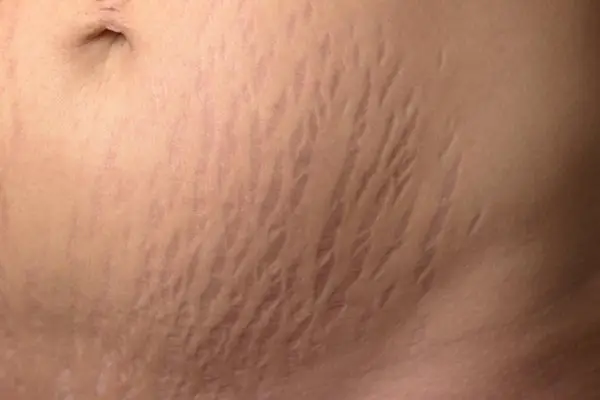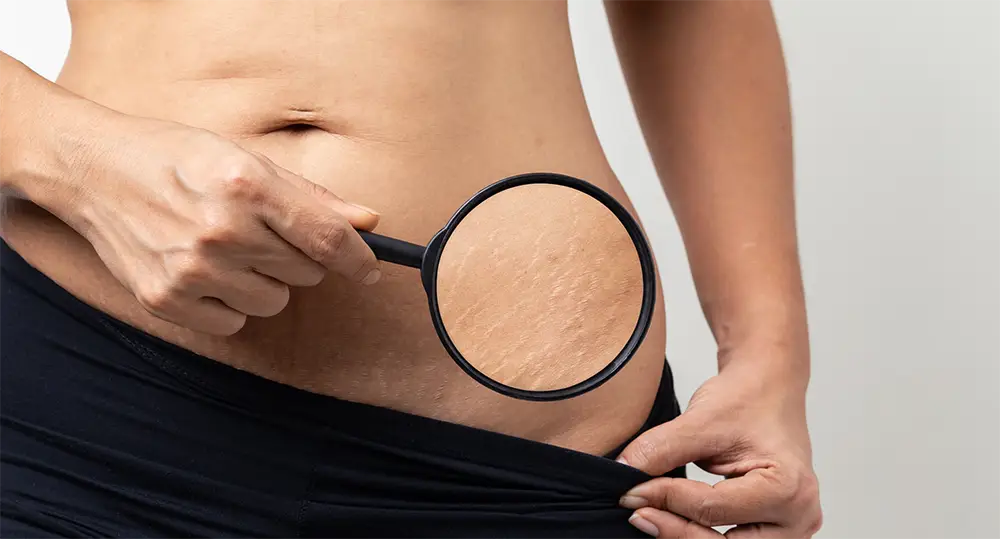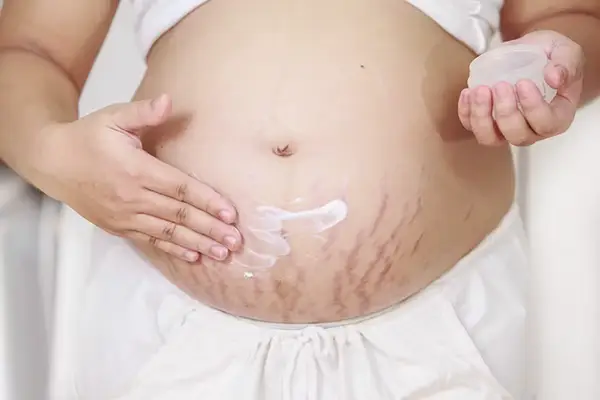Stretch marks, those linear streaks that often adorn our skin, are a common concern for many. These marks can be a source of self-consciousness, whether due to pregnancy, weight fluctuations, or growth spurts. In this article, we’ll explore various ways to get ride of stretch marks, reduce the appearance of stretch marks, highlighting both home-based solutions and professional treatments.
Table of contents
what are Stretch marks?
Stretch marks, scientifically known as striae, are a type of scarring that appears when the skin is stretched rapidly due to sudden growth or weight changes. They are common during pregnancy, puberty, and weight gain periods. Initially, these marks may appear as reddish or purplish lines that gradually fade to a lighter, almost silvery hue over time. The texture of stretch marks can be slightly raised and differ from the surrounding skin. Although they are a natural occurrence and pose no health risks, many seek treatments for cosmetic reasons. The likelihood of developing stretch marks can vary based on genetics, skin type, and the extent of skin stretching.
What Causes Stretch Marks?
- Rapid Skin Stretching: The primary cause of stretch marks is the rapid stretching of the skin. This can occur due to:
- Pregnancy: Stretch marks are common in pregnancy as the skin stretches to accommodate the growing baby.
- Growth Spurts: Teenagers often get stretch marks during puberty due to rapid growth.
- Rapid Weight Gain or Loss: Significant changes in weight over a short period can stretch the skin.
- Muscle Building: Rapid muscle growth, especially in bodybuilders, can also lead to stretch marks.
- Hormonal Changes: Hormonal fluctuations, especially in puberty and pregnancy, can increase the risk of developing stretch marks. Cortisol, a hormone produced by the adrenal glands, may also play a role, as it weakens elastic fibers in the skin.
- Genetic Factors: There’s a genetic predisposition to stretch marks. If your family members have them, you’re also more likely to develop them.
- Certain Health Conditions and Medications: Conditions like Cushing’s or Marfan syndrome and corticosteroid medications can weaken the skin and increase the risk.

Prevention of Stretch Marks
- Maintain a Healthy Weight: Avoid rapid weight gain or loss. If you need to lose or gain weight, aim to do it gradually to give your skin time to adapt.
- Nourish Your Skin: Keep your skin hydrated and nourished. Using moisturizers that contain ingredients like hyaluronic acid and glycerin can help maintain skin elasticity.
- Balanced Diet: Eat a diet rich in vitamins and minerals that promote skin health. Vitamins A, C, D, and E and zinc and protein are crucial for skin health.
- Stay Hydrated: Drinking plenty of water improves skin elasticity, potentially reducing the risk of stretch marks.
- Exercise Regularly: Regular physical activity can help maintain a healthy weight and improve circulation, which might contribute to skin health and elasticity.
- Avoid Certain Medications: If possible, avoid long-term use of oral or topical steroids, as they can decrease the skin’s ability to stretch.
- During Pregnancy and Puberty: Use preventive measures like hydrating the skin and maintaining a healthy diet and exercise routine. Specialized pregnancy oils and creams may also help.
- Monitor and Manage Hormonal Changes: If you have a condition that affects your hormones, managing it effectively can reduce the risk of stretch marks.
- Sun Protection: UV exposure can worsen the appearance of stretch marks, so sunscreen is vital for all skin types.
The Best Ways to Get Ride of Stretch Marks
Home Remedies for Stretch Marks
1. Aloe Vera
- Properties: Natural healing agent and a rich source of vitamins and enzymes.
- Application: Apply fresh aloe vera gel to the stretch marks, leave it on for 20-30 minutes, and then rinse with water.
- Rationale: Aloe vera is known for its skin-soothing and healing properties.
2. Coconut Oil and Olive Oil
- Properties: Moisturizing and healing effects.
- Application: Massage virgin coconut and olive oil into the affected areas until fully absorbed.
- Rationale: These oils are known for their moisturizing properties and can help reduce the appearance of stretch marks by keeping the skin supple and hydrated.
3. Lemon Juice
- Properties: Natural bleaching agent.
- Application: Rub fresh lemon juice on the stretch marks, leave it for 10-15 minutes, then rinse.
- Rationale: The acidity of lemon juice can help to lighten the scars.
4. Sugar Scrub
- Properties: Natural exfoliant.
- Application: Mix sugar with almond oil or olive oil and a few drops of lemon juice to create a scrub. Apply it to the stretch marks before showering.
- Rationale: Exfoliation can remove dead skin cells and promote skin regeneration.
5. Coffee Scrub
- Properties: Natural exfoliant.
- Application: Mix ground coffee with a small amount of water or coconut oil to create a paste. Gently massage the scrub on the stretch marks for a few minutes before rinsing.
- Rationale: Exfoliation can remove dead skin cells and promote skin regeneration.
Also Read: Everything You Need to Know About Body Scrubs and 2 DIY Recipes
6. Massage Therapy
- Regular massage of areas prone to stretch marks can enhance blood flow and promote healing. Natural oils during massage not only hydrate the skin but may also aid in healing due to their nutrient content.
7. Sun Protection
- UV rays can weaken the skin and exacerbate the appearance of stretch marks. Using sunscreen or protective clothing can prevent further damage and aid in the gradual fading of existing marks.
8. Acceptance and Patience
- Understanding that stretch marks are a normal part of many people’s lives and often fade over time can be a comforting approach. Embracing body positivity and giving the skin time to heal naturally is also beneficial for mental health.
Pros: Non-invasive, inexpensive, and beneficial for overall health.
Cons: Preventative in nature; less effective in treating existing stretch marks.
Over-The-Counter Treatments for Stretch Marks
Over-the-counter (OTC) treatments for stretch marks are widely available and can be an effective first step in managing their appearance. These treatments typically include creams, lotions, and oils formulated with active ingredients that target skin elasticity and repair. Here’s a closer look at these options:
1. Moisturizing Creams and Lotions
- Regular use of moisturizing creams and lotions can help keep the skin supple and elastic. Products containing cocoa butter, shea butter, and hyaluronic acid are popular for their hydrating properties. Consistent application, especially on areas prone to stretch marks, can help reduce their severity.
2. Retinoid Creams
- Retinoids, derived from Vitamin A, are known for their ability to promote skin renewal and enhance collagen production. Creams containing retinoids can be effective, particularly on newer stretch marks. However, they are not recommended for pregnant or nursing women.
3. Glycolic Acid
- Glycolic acid, an alpha-hydroxy acid (AHA), is used in many cosmetic products for its exfoliating properties. It can help in improving skin texture and may reduce the appearance of stretch marks over time. Glycolic acid is often combined with other moisturizing ingredients to prevent skin dryness.
4. Vitamin E Oil
- Vitamin E is known for its antioxidant properties and is a common ingredient in skin care products. Applying Vitamin E oil to stretch marks may help heal the skin and improve its elasticity.
5. Herbal and Plant Extracts
- Many OTC products contain herbal or plant extracts like aloe vera, Centella, or almond oil, known for their skin-healing properties. These natural ingredients can soothe and moisturize the skin, reducing stretch marks.
6. Exfoliating Scrubs
- Exfoliating the skin with scrubs that contain salt, sugar, or small beads can remove dead skin cells and promote circulation, potentially aiding in the reduction of stretch marks. Regular exfoliation can also enhance the penetration of other topical treatments, improving their effectiveness.
Pros: Easily accessible, non-invasive, and can be used at home.
Cons: May not be effective for older or more severe stretch marks. Some of them are not safe during pregnancy.

Professional Medical Treatments
1. Microdermabrasion
- This procedure involves gentle skin surface abrasion to remove dead skin cells, promoting new cell growth and collagen production. It’s particularly effective on older stretch marks, making them less noticeable.
2. Laser Therapy
- Laser treatments target stretch marks at a deeper level, stimulating the skin’s natural healing process. Different types of lasers are used depending on the age and severity of the stretch marks, offering tailored treatment options.
3. Microneedling
- It involves using fine needles to create tiny punctures in the skin, which triggers the body’s natural healing process, resulting in increased collagen and elastin production. This can improve the texture and appearance of stretch marks over time.
4. Chemical Peels
- Performed by a dermatologist, chemical peels involve applying a solution to the skin that causes it to exfoliate and eventually peel off. The new skin is usually smoother and less scarred. This can be effective for reducing the visibility of more pronounced stretch marks.
5. Surgical Methods
- In extreme cases, cosmetic surgery like a tummy tuck can remove the skin with stretch marks. However, this is an invasive option and usually the last resort.
Pros: Generally more effective for severe and older stretch marks. Long-lasting results.
Cons: More expensive, require visits to a specialist, and involve some recovery time. May cause side effects like redness, swelling, and bruising.

Understanding Skin Types and Stretch Marks
Stretch marks can appear differently on various skin tones but are a common experience across all.
- Normal Skin: Balanced in terms of oil and moisture. Stretch marks may be less visible on normal skin due to its natural elasticity and balanced hydration.
- Dry Skin: Lacks natural oils, making it less elastic and more prone to developing visible stretch marks. Dry skin may also take longer to heal, prolonging the appearance of stretch marks.
- Oily Skin: Produces more sebum, which may provide some natural protection against stretch marks. However, this does not make the skin immune to them.
- Combination Skin: Features oily and dry areas, meaning stretch marks may appear differently across various body parts.
- Sensitive Skin: May react more to stretch mark treatments, necessitating gentler and hypoallergenic options.
Factors Influencing Stretch Marks in Different Skin Types
- Elasticity and Collagen Production: Skin with higher collagen production and elasticity (often normal to oily skin) may develop fewer or less noticeable stretch marks.
- Hydration Levels: Dry skin is more susceptible to tearing when stretched, contributing to more pronounced stretch marks.
- Healing Capacity: Some skin types heal faster than others, affecting how quickly stretch marks fade.

Is It Possible to Treat Old Stretch Marks?
Treating old stretch marks, which are typically white or silvery, is challenging but not impossible. While they don’t respond as readily to treatment as newer marks, options like retinoid creams, laser therapy, microdermabrasion, and microneedling can improve their appearance. These treatments work by stimulating collagen production, improving skin texture, and blending the stretch marks with the surrounding skin. Home remedies, such as moisturizing oils and creams, can also help maintain skin hydration and slightly improve the appearance. Having realistic expectations is important, as these treatments often make stretch marks less noticeable rather than completely eradicating them. A consultation with a dermatologist is recommended to determine the most effective treatment plan for your specific case.
Conclusion
Choosing the right treatment depends on several factors: the age of the stretch marks, skin type, whether you’re pregnant or breastfeeding, personal health, budget, and how quickly you want to see results. While topical treatments can be a good starting point, particularly for new stretch marks, more severe cases might benefit from medical procedures. Lifestyle changes and home remedies are excellent for preventing and improving skin health. It’s always recommended to consult a dermatologist or healthcare provider to choose the most suitable option for your needs and circumstances.
While these strategies can help prevent or reduce the likelihood of developing stretch marks, it’s important to remember that for many people, stretch marks are a normal part of life and can occur despite taking preventive measures. Their presence is a natural body response to certain changes and is not harmful to health. If you’re concerned about stretch marks, consulting with a dermatologist can provide personalized advice and treatment options.
FAQs About Stretch Marks
- Who Is Most Likely to Get Stretch Marks?
- Anyone can develop stretch marks, but they are more common in pregnant women, adolescents going through puberty, individuals who experience rapid weight gain or loss, and bodybuilders.
- Are There Effective Home Remedies for Stretch Marks?
- Home remedies, such as aloe vera, coconut oil, and regular moisturizing, can help reduce the visibility of stretch marks, especially when they are new. However, their effectiveness varies and is generally more limited than medical treatments.
- How long does it take to see results from stretch mark treatments?
- The time frame varies depending on the treatment method, but consistent application over several weeks or months is typically needed.
- Can stretch marks completely disappear?
- While treatments can significantly reduce their appearance, they might not completely disappear.
- Are laser treatments safe for stretch marks?
- Laser treatments are generally safe when performed by a qualified professional, but consultation with
- Why Do Stretch Marks Change Color? Are red stretch marks bad?
- Initially, stretch marks appear as reddish or purple lines due to the blood vessels showing through the tearing of the dermis layer. Over time, as the marks heal, they fade to a lighter, more silvery color as the blood vessels contract.
Also Read:
Essential Vitamins and Supplements for Healthy Skin and Hair
Beauty in Your Kitchen: 10 DIY Mask Recipes for natural Glamour




